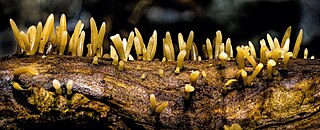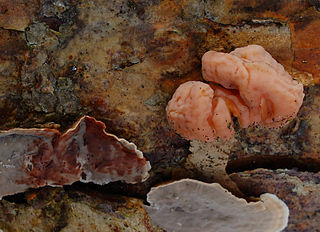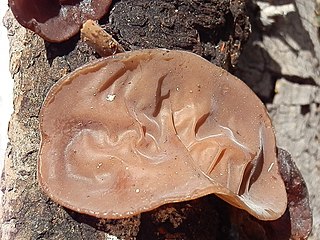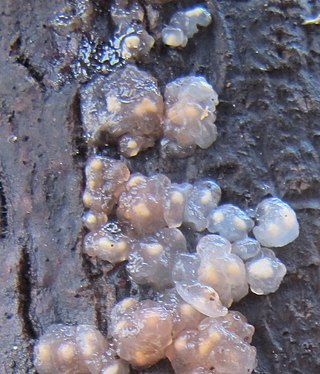
Heterobasidiomycetes, including jelly fungi, smuts and rusts, are basidiomycetes with septate basidia. This contrasts them to homobasidiomycetes, including most mushrooms and other Agaricomycetes, which have aseptate basidia. The division of all basidiomycetes between these two groups has been influential in fungal taxonomy, and is still used informally, but it is no longer the basis of formal classification. In modern taxonomy homobasidiomycetes roughly correspond to the monophyletic class Agaricomycetes, whereas heterobasidiomycetes are paraphyletic and as such correspond to various taxa from different taxonomic ranks, including the Basidiomycota other than Agaricomycetes and a few basal groups within Agaricomycetes.

The Tremellaceae are a family of fungi in the order Tremellales. The family is cosmopolitan and contains both teleomorphic and anamorphic species, most of the latter being yeasts. All teleomorphs in the Tremellaceae are parasites of other fungi, though the yeast states are widespread and not restricted to hosts. Basidiocarps, when produced, are gelatinous.

The Auriculariaceae are a family of fungi in the order Auriculariales. Species within the family were formerly referred to the "heterobasidiomycetes" or "jelly fungi", since many have gelatinous basidiocarps that produce spores on septate basidia. Around 100 species are known worldwide. All are believed to be saprotrophic, most growing on dead wood. Fruit bodies of several Auricularia species are cultivated for food on a commercial scale, especially in China.

The Tremellales are an order of fungi in the class Tremellomycetes. The order contains both teleomorphic and anamorphic species, most of the latter being yeasts. All teleomorphic species in the Tremellales are parasites of other fungi, though the yeast states are widespread and not restricted to hosts. Basidiocarps, when produced, are gelatinous.

The Hyaloriaceae are a family of fungi in the order Auriculariales. Species within the family have gelatinous basidiocarps that produce spores on septate basidia and, as such, were formerly referred to the "heterobasidiomycetes" or "jelly fungi". All appear to be saprotrophic, growing on dead wood or plant remains. Less than 30 species are currently included within the Hyaloriaceae, but the family has not been extensively researched.

Auricularia is a genus of fungi in the family Auriculariaceae. Basidiocarps are typically gelatinous and ear-shaped, with a slightly downy to conspicuously hirsute upper surface and an under surface that is smooth, wrinkled or veined. All species grow on wood. Several Auricularia species are edible and commercially cultivated on a large scale in China and East Asia.

Exidia is a genus of fungi in the family Auriculariaceae. The species are saprotrophic, occurring in attached or recently fallen dead wood, and produce gelatinous basidiocarps. The fruit bodies are diverse, pustular, lobed, button-shaped or cup-shaped. Several species, including the type species Exidia glandulosa, have sterile pegs or pimples on their spore-bearing surface. The genus has a cosmopolitan distribution and around 20 species are currently recognized worldwide. Initial molecular research indicates the genus is artificial.

Exidia nigricans is a jelly fungus in the family Auriculariaceae. It is a common, wood-rotting species throughout the Northern Hemisphere, typically growing on dead attached branches of broadleaf trees. It has been much confused with Exidia glandulosa.

Sebacina is a genus of fungi in the family Sebacinaceae. Its species are mycorrhizal, forming a range of associations with trees and other plants. Basidiocarps are produced on soil and litter, sometimes partly encrusting stems of living plants. The fruit bodies are cartilaginous to rubbery-gelatinous and variously effused (corticioid) to coral-shaped (clavarioid). The genus has a cosmopolitan distribution.

Tremellodendropsis is a genus of clavarioid fungi in the family Tremellodendropsidaceae. Species are distinguished microscopically by having partly septate basidia, a feature that led to their former placement within the Auriculariales or Tremellales. Molecular research, based on cladistic analysis of DNA sequences, has, however, shown that they form a distinct group within the Agaricomycetes.
Elmerina is a genus of fungi in the order Auriculariales. Basidiocarps are formed on dead wood and are either bracket-like with a poroid hymenium or densely clavarioid. Species are known from East Asia and Australia.

Naematelia encephala is a species of fungus producing pink, brain-like, gelatinous basidiocarps. It is widespread in north temperate regions and is parasitic on another species of fungus that grows on dead attached and recently fallen branches of conifers. In the UK, its recommended English name is conifer brain.

Auricularia americana is a species of fungus in the family Auriculariaceae found in North America and East Asia. Its basidiocarps (fruitbodies) are gelatinous, ear-like, and grow on dead conifer wood.

Auricularia angiospermarum is a species of fungus in the family Auriculariaceae. Basidiocarps (fruitbodies) are gelatinous, ear-like, and grow on dead wood of broadleaf trees. It is a North American species and was formerly confused with Auricularia auricula-judae which is confined to Europe.

Myxarium is a genus of fungi in the family Hyaloriaceae. Basidiocarps are gelatinous and effused or pustular. The genus is cosmopolitan. All species grow on dead wood or dead herbaceous stems.
Heteroscypha is a genus of fungi in the order Auriculariales. Species form cup-shaped, cyphelloid basidiocarps with basidia that are wholly or partly septate. They are presumed to be saprotrophic, growing on dead wood. Originally described in the Tremellales, the genus was placed in its own family, the Heteroscyphaceae, by Jülich and included within the Auriculariales by Wells. Further research is required to determine its true disposition.
Naohidea sebacea is a species of fungus in the order Naohideales. The order is currently monotypic, having only one family, one genus, and one species. Basidiocarps of Naohidea sebacea form small, gelatinous pustules on wood-inhabiting species of Botryosphaeriaceae. Microscopically, they produce long, slender, auricularioid basidia and amygdaliform (almond-shaped) basidiospores.
Platygloea is a genus of fungi belonging to the class Pucciniomycetes. Basidiocarps of the type species are disc-shaped, gelatinous, and occur on dead wood, probably as a saprotroph. Microscopically, all species of Platygloea sensu lato have auricularioid basidia. Currently the genus contains a heterogeneous mix of auricularioid fungi not yet accommodated in other genera.
Hirneolina is a genus of fungi in the order Auriculariales. Basidiocarps are effused, waxy, and occur on dead wood. Only the type species, described from Ecuador and reported from Brazil, is currently confirmed as belonging to the genus.
Bourdotia is a genus of fungi in the order Auriculariales. Basidiocarps are effused, waxy, and occur on dead wood. Macroscopically they resemble waxy species of Exidiopsis, but are distinguished microscopically by the presence of gloeocystidia and "myxarioid" basidia. Only the type species, described from France, is currently confirmed as belonging to the genus.



















